This
post was originally published on
this siteOriginally posted at: http://www.nerdfitness.com/
This is an article from NF Rebel Chef Noel.
For some of us Rebels, a grocery store is a lot like a video game dungeon. It’s dark, wet, oozy, and full of giant spiders…Okay, well maybe not the spiders part. But sometimes it feels that way.
It reminds me of a level from Legend of Zelda! Whenever you, Link, entered a new dungeon, whether it was the Deku Tree or the Water Temple, after wandering around for some short amount of time, inevitably, you found a map and a compass. The map and compass helped you find your other necessities to complete the dungeon: Hidden doors, boss keys, and hook shots. Today, games just have this stuff built right in from the start.
You walk in, and you’re overwhelmed. You know not to shop in the middle aisles, but you’re trying to eat healthy and cook for yourself for the first time in your life. You walk around the perimeter a few times and find things like butter, eggs, meat, and vegetables, but there are some things on your list that are missing (coconut oil? bag of almonds?).
Not only that, but every time you find something and move on to seeking out the next item on your list, it seems like you have to walk back across the freaking store to find it, or up and down 2-3 aisles until you by some miracle stumble across whatever you’re looking for. (Or if you’re like me, you walk around until you’ve completely forgotten what you were looking for in the first place!) I know, guys, it’s freaking hard!
If you’re one of those people who gets a mild panic attack when the bright florescent lights of your local supermarket hit you, if you get attacked by a horde of skulltula immediately upon entering, or if you just need a little help figuring out how to wheel your cart around the place without walking the length of The Shire to Mordor, this article is for you.
Once you’ve got the sections of your store down, it’s a breeze. So don’t feel intimidated just yet. We’re going to help you dominate the supermarket sweep and shop like a boss.
A quick note: Nerd Fitness Yoga is available at a reduced rate until tomorrow night (Tuesday)! See the PS in this article for details.
You found a map!
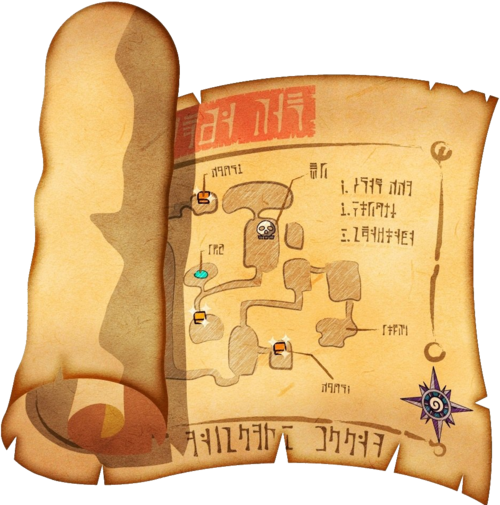
First, we’re going to talk about the general layout of the store. In this article, you read about how the store is set up with healthy things around the perimeter, while unhealthy junk food awaits in the middle aisles.
Let’s take a walk through an average store just to survey our surroundings. Every store is different, but generally, your fruits and veggies will usually be on one side of the store. Keep walking around the perimeter and you’ll come to either meat or dairy. Keep walking and you’ll likely stumble across things like lunch meats, cheeses, or a frozen section. Stores that carry alcohol often keep these items on the perimeter as well. As you walk through your store, you might notice that these things are out of order, but don’t fret. The important part is that these things are around the perimeter.
Check out this amazingly well drawn map to get an idea of my local grocery store’s perimeter layout, likely similar to yours:
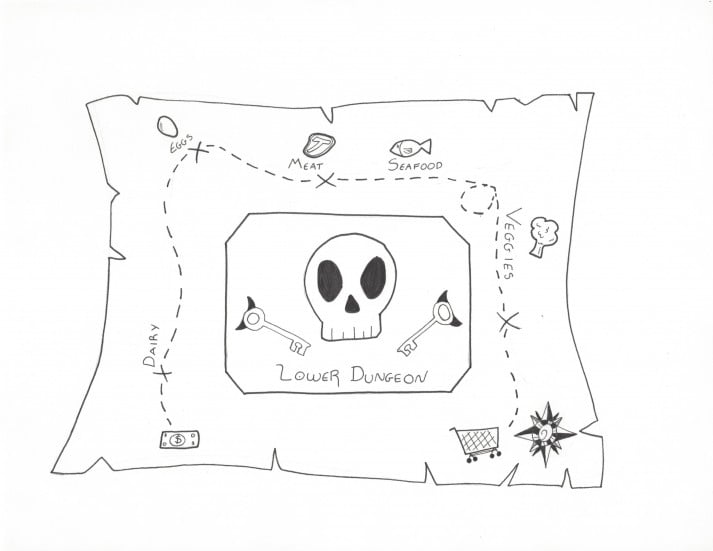
Now, let’s talk about those middle aisles: the lower levels of the dungeon if you will. You might be more familiar with these aisles if this is the kind of food you’ve shopped for before.
Entering the Dungeon
You know where the frozen pizzas and pudding cups are, and you might be pretty comfortable with the layout of the candy aisle. You might know where to look for Goldfish crackers and Mountain Dew. Hey, no judgement – even “health food” stores like Whole Foods stock their shelves with cookies and gummy bears. Know where the dangers lie.
How do you deal with these mobs? First of all, if your willpower points are running low, just stay away from these places. Just like you wouldn’t charge into a boss battle on low HP, if you don’t know whether you can get out of the aisle without stocking up on garbage, don’t even set foot in there. This is doubly true if you are shopping on an empty stomach. Stick with the basics (veggies and protein), and get out alive. Come back when your willpower points are full and live to fight another day! Remember, 60% to 70% of purchases in grocery stores are UNPLANNED! So, do NOT underestimate these mobs!
However, for some of the items on your list, you’re very likely going to have to walk through some of the middle aisles. Especially if you’re stocking your paleo pantry.
Again, every store is different, but the middle aisles are often organized by type of food or product: canned meats/vegetables, cereals and other “breakfast foods,” baking items, food storage (Ziploc bags and Tupper wear), medicine… you get the idea.
If you are venturing down the aisles, here are the ones you’ll likely need to stock up your paleo pantry:
- Baking goods – nuts are often kept in these aisles.
- Canned meat – for canned tuna.
- Canned vegetables – if you’re into eating canned veggies or need tomatoes or tomato paste for Paleo Spaghetti, this is where you’ll find them.
- Frozen vegetables – if you prefer this over fresh or you want to keep these on hand for emergencies
- A bulk section – if your grocery store has it, nuts are often kept here and, because you can buy items in this section in the quantity you desire, they can be cheaper than buying a brand-name bag of almonds from the baking aisle.
- Jams/jellies – this is where the almond butter is kept – stay focused!
- The spice aisle – spices and sauces for cooking are often in this aisle, as are cooking oils and vinegar.
If you’re looking for items like coconut milk or soy sauce, check to see if your grocery store has an “ethnic foods” or “Asian foods” section. These items are often located here.
Watch this video to get an idea of what your grocery store run is going to look like. Consider it a shopping speed run.
Now get ready, here’s the full strategy guide. We’re going to walk you through the entire dungeon, from meal plan to recipe, to grocery list, to grocery store.
Acquire these Items, Beat the Dungeon
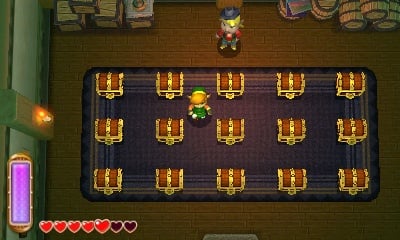
Now that you know the layout of the store, it’s time to do the at-home prep work starting with the question we all ask ourselves…”WTH am I going to eat tonight?!” Next we’ll check out the recipe, make the grocery list, and wheel your cart through the aisles.
Once you’ve decided what you’re going to eat tonight, you’re going to look up the recipe. I’ve chosen Paleo Shepherd’s Pie. Now we’re going to make a shopping list out of that sucker. Grab 2 pieces of paper and a #2 pencil. (Okay, not exactly a #2 pencil. Any writing implement will do. But bonus points for #2).
First write down the ingredients from the recipe in the same order as the recipe. If your recipe has two sections like the Shepherd’s Pie does, you can eliminate any re-occurring ingredients (you only need to buy these once) or any stuff you already have (you don’t need to re-stock this item until you’re out.) Here’s what mine looks like:
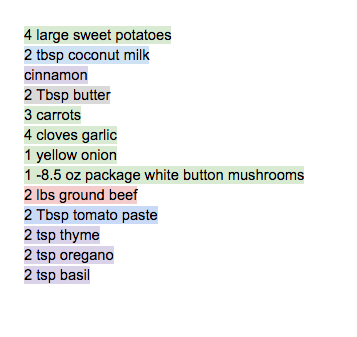 Note* (My list has foods color coded by section to make it easy for you to visualize the section each food belongs in. You don’t have to do this when you make your list.)
Note* (My list has foods color coded by section to make it easy for you to visualize the section each food belongs in. You don’t have to do this when you make your list.)
Now, if you’re anything like me, you’re going to want to get in and out of the store as quickly as possible. In order to have the most efficient shopping experience of your life, you’re going to re-organize that shopping list. You have a general idea of where things are in different sections of the store now. Take your list and reorganize it into different sections so you can just walk through that aisle/section, grab what you need off the shelf and move on to the next section. Here’s my reorganized list:
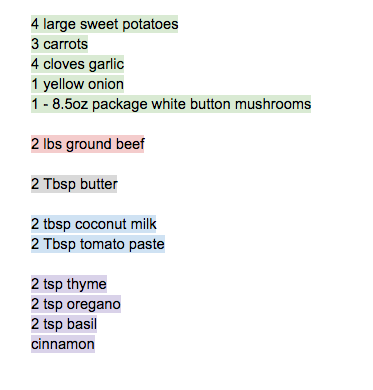
You can see how I re-organized the list by section. Veggies are together, spices are together, canned goods are together, and meat and dairy are on their own. (Also, after cooking this just once, you’ll have spices and leftovers and your list will be cut in half for next time!)
Now with grocery list in hand, you can buzz through the aisles and get in and out as quickly as possible!
Help! i can’t find ___!

You’ve been in the grocery store for 30 minutes. You’ve dominated most of your list, but there’s that ONE ITEM that you cannot freaking find. You’re frustrated and you just want to get out of there. What do you do?
- You can just leave without it. (womp womp)
- Or you can talk to an NPC.
Grocery store employees are often super helpful, and I’ve found that when I ask them for something, they’re more than happy to take a break from whatever they’re doing to help you look (if it’s not in the section they work in, they might end up joining your search party too).
Gather up your 20 seconds of courage, find an NPC, and politely ask them for help. You might be afraid they’ll be rude. You might think they’ll think you’re stupid for getting lost. Or there’s always the possibility they just don’t carry what you’re looking for in the store at all. If any of that happens, remember THAT’S OKAY. The quickest way to be sure is to JUST ASK. If you need some pointers, check out this article on confidence and this article on approaching people before you hit the store.
And what happens if the grocery store just doesn’t have what you’re looking for? You can either focus on the big wins and leave without that ingredient if it’s optional (coconut milk in the Shepherd’s Pie recipe) or conjure a spell and substitute a different one (for example use ground pork, turkey or chicken if they don’t have ground beef).
Don’t let these TINY bumps in the road distract you from the big wins – figure out a way to make the meal!
It’s dangerous to go alone! Take this!

Now it’s time to hit the store! If your hands are still feeling cold and clammy at the thought of walking into the market alone, take a friend with you. You can shop together or split the list in two. Each person takes half and you dominate the store in half the time.
If shopping sounds too much like a chore to you, try gamifying it!
Ways to gamify grocery shopping:
- Supermarket sweep – get through the store in the least amount of time possible. Use the rules from this post.
- Race a friend – split your list in half with a spouse or roommate and each of you tries to complete your list and get through the checkout line before the other person. Be careful! Don’t run over any old ladies or wild children! You’ve been warned!
- Spend the least amount of money possible – buy whatever’s on sale or cheap. If your recipe calls for chicken breast, but the store is having a great sale on thighs ( and you feel confident enough in your cooking). Buy the thighs and alter the recipe a little for the sake of saving some dough.
Now that you have your map, your compass, and a plan, it’s time to get out there and use them in the real world. Let us know how it went!
- Did you get your shopping done in record time?
- Was the virtual grocery store tour helpful?
- How do you get your grocery shopping done in the most efficient way?
Let us know in the comments!
-Noel
PS from Steve – Nerd Fitness Yoga is available for a reduced price until tomorrow (Tuesday) night at 11:59pm EST! Join thousands of Rebels who are getting more flexible, building a healthy habit, and leveling up their lives! See you inside the course!
###
Photos: zelda wikia: windwaker map, clement127: angry hulk, Nintendo news: a link between worlds screenshot
Video music: Eric Skiff: 8-bit Music – Chibi Ninja
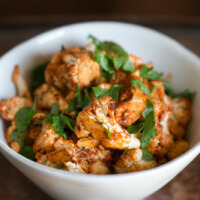

 For today’s edition of
For today’s edition of 














 For now classes are 6pm and 640pm at 2840 Wildwood st in the Boise Cloggers studio.
Book your class NOW!
click this ==>
For now classes are 6pm and 640pm at 2840 Wildwood st in the Boise Cloggers studio.
Book your class NOW!
click this ==>








